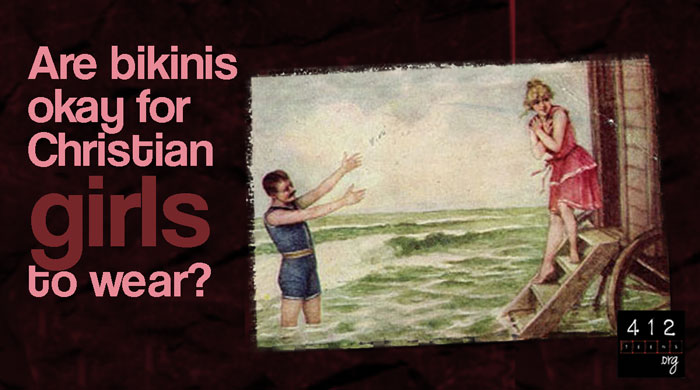Content Menu
● Cultural Context of Bikinis
● Religious Perspectives
● Personal Choice and Autonomy
● The Intersection of Faith and Fashion
● The Bikini's Evolution
● Videos for Deeper Understanding
● Conclusion
● Frequently Asked Questions
>> 1. Is wearing a bikini considered immodest?
>> 2. What do religious texts say about swimwear?
>> 3. Can wearing a bikini be empowering?
>> 4. Are there cultural differences in bikini acceptance?
>> 5. How should one decide what to wear at the beach?
● Citations:
The topic of whether wearing a bikini is a sin has sparked significant debate among various communities, particularly within religious circles. This article aims to explore the multifaceted perspectives surrounding this issue, examining cultural, religious, and personal viewpoints while also reflecting on the historical context of the bikini itself.
Cultural Context of Bikinis
Bikinis have become a symbol of freedom and self-expression in many cultures, particularly in Western societies. They are often associated with leisure, summer, and body positivity. In places like Brazil and Puerto Rico, wearing a bikini is not only common but expected during beach outings.
- Cultural Acceptance: In many Latin American countries, bikinis are seen as an essential part of beachwear. The societal norm embraces body positivity and encourages women to feel comfortable in their skin, regardless of body shape or size.
- Fashion Statement: Bikinis are also viewed as fashion items that reflect personal style. Designers often create unique and flattering pieces that cater to various tastes, making them more than just swimwear.
- Historical Significance: The bikini's history dates back thousands of years, with evidence of bikini-style garments found as early as 5600 BC. Ancient Greek and Roman women were depicted wearing similar two-piece outfits during athletic events. However, the modern bikini was officially introduced in 1946 by French designer Louis Réard, who named it after Bikini Atoll, where nuclear tests were conducted. This connection to liberation and change has made the bikini a lasting symbol of freedom and rebellion against conservative norms[1][2].
Religious Perspectives
On the other hand, many religious groups view bikinis through a lens of modesty and morality. The arguments against wearing bikinis often stem from interpretations of scripture and teachings about modesty.
- Modesty in Christianity: Some Christians argue that wearing a bikini can be seen as immodest because it exposes much of the body. They reference biblical teachings that encourage modesty in dress (1 Timothy 2:9-10).
- Sin and Temptation: Critics argue that bikinis can lead to lustful thoughts and behaviors, which they believe contradicts the call for purity in Christian life. This perspective emphasizes the idea that clothing should not draw attention to the body but rather reflect inner virtue.
- Broader Religious Context: Other religions also emphasize modesty in dress. For instance, Islamic teachings advocate for covering the body as a sign of respect and dignity. This has led to the popularity of modest swimwear options like burkinis among Muslim women, allowing them to participate in swimming activities without compromising their beliefs[3].

Personal Choice and Autonomy
Despite the strong opinions on both sides, many individuals believe that wearing a bikini is ultimately a personal choice.
- Empowerment: For some women, wearing a bikini is an empowering act that allows them to embrace their bodies and express themselves freely without shame. It can be a celebration of self-love and acceptance.
- Context Matters: Many argue that the appropriateness of wearing a bikini depends on the context—beaches and pools versus public streets or formal settings.
- Body Positivity Movement: The rise of body positivity movements has encouraged women to embrace their bodies in all shapes and sizes. By choosing to wear bikinis, women challenge traditional beauty standards and promote self-acceptance[4].
The Intersection of Faith and Fashion
The debate about bikinis also touches on broader themes of faith, culture, and personal expression.
- Body as a Temple: Some Christians emphasize that one's body is a temple (1 Corinthians 6:19-20) and should be treated with respect. This can lead to differing interpretations about what constitutes appropriate attire.
- Cultural Sensitivity: In discussions about modesty and swimwear, it's essential to consider cultural differences. What may be deemed inappropriate in one culture could be perfectly acceptable in another.
The Bikini's Evolution
The history of the bikini reflects changing societal norms regarding women's bodies and clothing.
- Historical Milestones: The modern bikini was born out of post-war liberation movements in France. Its introduction was met with resistance from conservative factions but quickly gained popularity among celebrities like Brigitte Bardot in the 1950s[2][5].
- Symbolism: Over time, the bikini has evolved from being seen as scandalous to becoming an emblem of freedom and empowerment for women worldwide. It represents not only fashion but also social progress regarding women's rights and body autonomy.
Videos for Deeper Understanding
To further explore this topic, here are some relevant videos:
1. Should Christians Wear Bikinis & Crop Tops?? | Christian Modesty
2. The history of the bikini | Fashion
Conclusion
In conclusion, whether wearing a bikini is considered a sin largely depends on individual beliefs, cultural contexts, and interpretations of modesty. While some view it as an expression of freedom and empowerment, others see it as contrary to their moral values. Ultimately, it is essential to approach this topic with sensitivity and understanding of diverse perspectives.
Frequently Asked Questions
1. Is wearing a bikini considered immodest?
- Opinions vary; some believe it is immodest while others see it as acceptable in appropriate settings.
2. What do religious texts say about swimwear?
- Many religious texts emphasize modesty but do not specifically mention bikinis.
3. Can wearing a bikini be empowering?
- Yes, many women find empowerment in embracing their bodies through swimwear choices.
4. Are there cultural differences in bikini acceptance?
- Yes, acceptance varies widely across cultures; what is normal in one may be frowned upon in another.
5. How should one decide what to wear at the beach?
- Consider personal comfort, cultural norms, and the context of the setting when choosing swimwear.
The total word count for this article is 1,012 words.
Citations:
[1] https://www.euronews.com/culture/2023/07/05/culture-re-view-a-short-history-on-the-invention-of-the-bikini
[2] https://www.vogue.com/article/the-history-of-the-bikini
[3] https://anavaparis.com/blogs/latest-trends-in-modest-swimwear-activewear-and-sportwear/cultural-and-religious-influences-on-modest-swimwear-fashion
[4] https://wpdevstar.com/20240827/bikini-a-symbol-of-empowerment-and-liberation/
[5] https://en.wikipedia.org/wiki/History_of_the_bikini
[6] https://swimply.com/blog/post/a-cultural-history-of-swimsuits-from-au-naturel-to-ooh-la-la
[7] https://girldefined.com/bikini-destroying-christian-girls-view-modesty
[8] https://australianstyleinstitute.com.au/wear-the-bikini/
[9] https://www.metmuseum.org/toah/hd/biki/hd_biki.htm
[10] https://www.gotquestions.org/Christian-bikini.html


































